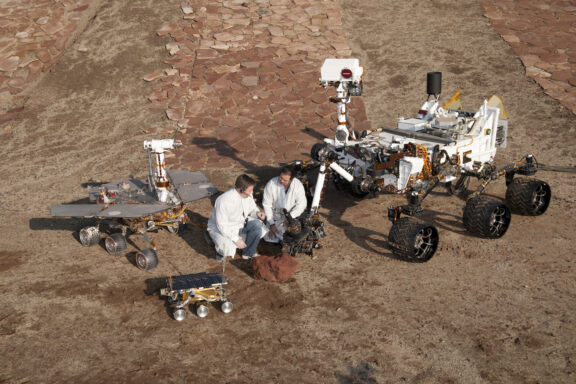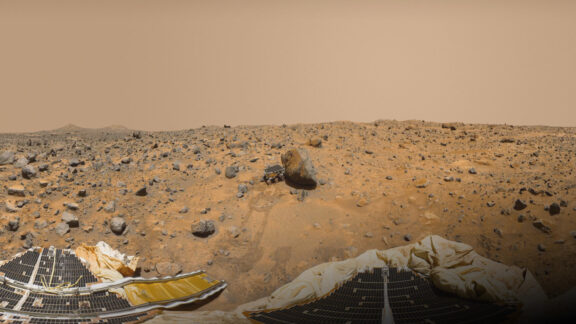Mars Pathfinder, the start of modern Mars exploration
Highlights
- The Pathfinder mission deployed the first-ever wheeled rover on Mars.
- Technologies developed for Pathfinder paved the way for future, more sophisticated exploration of Mars.
- Pathfinder helped The Planetary Society get the names of its members to the surface of Mars.
What was NASA’s Mars Pathfinder mission?
On July 4, 1997, NASA landed a spacecraft on Mars, Pathfinder, for the first time in about two decades, following the successful Viking 1 and 2 missions. It was a big step for the space agency and for Mars exploration in general.
While the flagship Viking missions cost a whopping $7 billion (inflation-adjusted for 2020), Pathfinder was relatively low-cost at $485 million. And yet Pathfinder carried cutting-edge technologies, successfully demonstrating a novel method of landing on Mars with protective airbags and bringing the first-ever wheeled rover — named Sojourner in a Planetary Society-run contest — to explore the red planet.
The roughly meter-tall, pyramid-shaped Pathfinder lander with its petal-shaped solar panels and the wagon-sized, six-wheeled Sojourner rover each studied Mars for almost three months. The lander took numerous atmospheric measurements while also imaging the Martian surface. The rover explored hundreds of square meters of area around the lander, taking 550 surface photographs and chemically analyzing 16 varied locations to determine their composition and thus help scientists probe their origin.
After the mission, the lander — which carried the names of over 100,000 Planetary Society members on a microchip — was named the Sagan Memorial Station in honor of our co-founder Carl Sagan.
Pathfinder was developed in just three years as the second mission under NASA’s then-fresh Discovery program, which aimed to send highly focused science missions across the solar system on a fast track and low budget. Since Pathfinder, the program has led to more hugely successful mission firsts, from the MESSENGER spacecraft orbiting Mercury to Dawn visiting Vesta and Ceres.
Where did Pathfinder land?
Scientists used Viking orbiter imagery and data to select the rocky Martian plains of Ares Vallis as Pathfinder’s landing site because it offered unique access to a past watery Mars. Thanks to improvements in landing techniques since the Vikings, Pathfinder touched down just 19 kilometers (about 12 miles) southwest of the ideal target point, still well within Ares Vallis and at the intended general location of 19 N, 33 W. This region is near the mouth of an ancient water channel, where a catastrophic flood is thought to have flown through, depositing a wide variety of telltale rocks to study.
What were the scientific results from Pathfinder?
The Pathfinder lander and Sojourner rover helped us understand Mars’ past and present conditions. The lander’s meteorology sensors frequently detected dust devils, now known to be common on the planet. Magnets on the lander found Martian dust to be highly magnetic, which scientists think is due to the presence of maghemite — a very magnetic form of iron oxide. The iron may have been brought to the surface from Mars’ crust by an active water cycle during the planet’s habitable past, but then freeze-dried on dust particles as Mars evolved.
The Sojourner rover used its X-ray spectrometer to identify what rocks and soil in the flood plain of Ares Vallis were made of. It found plenty of Earth-resembling silica-rich volcanic rocks as well as water-washed rounded cobbles and pebbles.
How did Pathfinder start modern Mars exploration?
With the Pathfinder mission, NASA developed foundational technologies for the future, increasingly more ambitious Mars missions to iterate on. Successors to Sojourner — the Spirit and Opportunity Mars Exploration Rovers — landed on the red planet in 2004 using a similar airbag landing technique and explored the surface using advanced versions of Sojourner’s rocker-bogie suspension system for good mobility.
The two-way Earth-Mars communications lag of up to 42 minutes also demanded that the Sojourner rover be able to make safe autonomous decisions for situations where there would be no time for humans to be in the loop. This is now a staple feature of all robotic Mars rovers. Moreover, scientists determined the mechanical properties of Martian soil based on Sojourner’s images of its wheel tracks and their sinkage, which provided key information for future rovers to the Red Planet.
NASA officials have compared Ingenuity, the first helicopter on Mars, to Sojourner. Former NASA Jet Propulsion Laboratory (JPL) Director Michael Watkins remarked that just like Sojourner demonstrated the importance of mobility in planetary exploration and led to modern sophisticated rovers like Perseverance, Ingenuity marked the start of exploring Mars from the third dimension.

Pathfinder, space exploration, and the internet
Perhaps the least known impact of the Pathfinder mission is NASA’s switch to using the internet as the primary means to communicate with the public. Rather than just manually distributing physical prints of select images at media conferences and sending over scanned images to TV stations and news outlets days after a major mission event, NASA provided fresh Pathfinder images from Mars directly on the then-young World Wide Web with little delay. The mission garnered more than 200 million views between July 4-8, 1997, setting a web traffic record.
By the time the Mars Exploration Rovers landed in 2004, NASA had massively upgraded its website infrastructure to gracefully handle the peak 109 million views it received in a day as well as the 50,000 people watching the live webcast. Pathfinder forever changed not only how the public sought information on space missions but any publicly relevant live event — in near real-time.
Acknowledgments: This page was initially authored by Jatan Mehta in 2022.


 Explore Worlds
Explore Worlds Find Life
Find Life Defend Earth
Defend Earth


